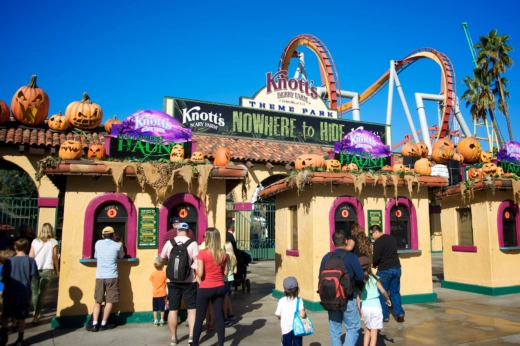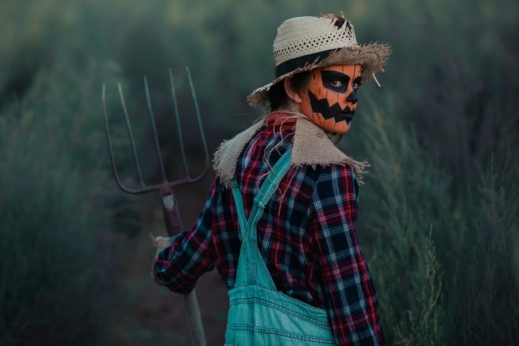On the farm, haunted houses and barns invite guests into a narrative about rural identity.

When two young members of a farming community in North Carolina fell in love, there was nothing stopping them—except the generations-old blood feud between their families. When their elopement plans were foiled, resulting in the death of her betrothed, the left-behind young woman took to the woods near the farm, forever haunting the community, and specifically, the farm she once called home.
This is the story that guests at one haunted farm are told when they visit during the Halloween season. Another haunted farm attraction in Alabama promises to bring you closer to the “creatures and killers” of the farm. Another, in South Carolina, invites you to its “desolate farm” where the inhabitants are hoping “to make you this year’s harvest!”
Haunted farm attractions are not homogenous—some are real working farms that incorporate haunted attractions into their seasonal offerings as a way to supplement farm revenue and connect with the community.
Other haunted farm attractions aren’t farms at all but haunted house businesses that use the idea of a haunted farm to inspire terror. The popularity of this concept is more than a fun seasonal activity, though. It also engages with longstanding narratives about rurality, performing them for a fearful audience.
Haunted houses and cultivating screams
Growing up a theater kid, it wasn’t hard for Betty Aquino to fall in love with farm haunted houses. After college, she found herself working for a haunted house attraction on a farm as a make-up artist. Aquino went on to do her graduate work at George Mason University and completed her thesis work on how haunted house attractions on farms rely on rural tropes that can be both empowering and problematic.
For small farms that face pressures from big agriculture and high land prices, using things such as haunted house attractions to supplement income is a way to adapt. But, in some cases, to make it work, haunted farmhouses often rely on the stereotypes of the rural “other”—the idea that whatever happens on a farm after dark is scary and unknown.
Haunted houses are more story driven than other farm attractions such as corn mazes or pumpkin picking, often relying on a pre-constructed narrative. Capitalism is a driving force in these narratives, says Aquino, informing depictions of gender, race and class and occasionally referencing a community’s own trauma. In one farm haunt she visited in Michigan, Aquino felt that what she saw was representative of the automobile industry’s history in the state. The villain in the story comes to the town and promises jobs, only to use dark magic against the town instead.
“One of their haunts has this narrative of a town that has lost its industry,” says Aquino. “And it is essentially this ghost town that’s very much a mirror of many towns in Michigan.”
The “ghost town” narrative was one Aquino saw a lot during her field research—as was “hillbilly horror.”
“I think those narratives are very reflective of their near-death experiences as farms,” says Aquino. “And they’ve had to pivot and rebuild their businesses.”

A haunted attraction that was once a farm. (Photography from Shutterstock)
The benefits of haunted houses
Although haunted houses existed in some form or another long before this, historian David Skal argues that the popularity of haunted houses in general grew significantly after Disney opened the Haunted Mansion attraction in 1969.
As we wrote a few years back, Halloween is a holiday with deep agricultural roots. It marks both the end of the harvest season and a time of year when the connection to the spirit world is the strongest. Opening haunted houses on farms is a natural extension of this connection.
Perhaps thanks to the associations between Halloween and agriculture, many farms have had success introducing haunted farm attractions into their business. According to the USDA, between 2002 and 2017, agritourism revenue more than tripled. This figure represents more than Halloween attractions, but the fall season is a big draw for a lot of farms.
Kevin McCall, managing partner of McCall’s Pumpkin Patch in Moriarty, New Mexico, says that adding haunted attractions to the farm’s offerings has been a helpful source of revenue. The farm started by introducing a haunted hayride, but “it’s hard to haunt on a hayride,” he says. Then it added a haunted corn maze with about 50 actors and props. In the 2000s, the farm converted its cattle barn into a haunted barn attraction. It’s woven all together with the fictional narrative of a farmer who, in response to an interstate being built through the farm, begins slaughtering tourists.
McCall’s Pumpkin Patch draws visitors from Albuquerque and Santa Fe, and this season, it sold out. This showcases the significant benefit that Halloween haunts can have for farms—McCall says the business it gets from haunting allows more freedom and security with the agricultural side of the business.
“It’s allowed us to be a very different type of farmer,” says McCall.

A person dressed up for Halloween on the farm. (Photography from Shutterstock)
The future of haunted farm attractions
In Rural Remix’s new podcast, “The Rural Horror Picture Show,” hosts Susannah Broun and Anya Petrone Slepyan talk about classic films in the folk horror genre and how depictions in horror films such as “Deliverance” and “The Hills Have Eyes” portray rural spaces as scary places where horrors are born. They point out that this narrative has old roots in popular culture.
When it comes to the future of haunted house attractions on farms, Aquino concludes that these haunts are a space of evolving rural identity.
As a genre, she says, horror has the ability to critique and interrogate many institutions and ideas. Rural communities are also capable of challenging the status quo—through things such as unions and initiatives such as the Black Appalachian Coalition, which works to fight the erasure of Black people from narratives about Appalachia. Rural haunts can be a space to question tropes about rurality.
“I hope that there is a return to radical roots in rural spaces,” says Aquino, “and that we continue to see more diversity in the narratives and the people working at these places.”
Halloween and agriculture have always been linked, and seasonal haunts give us the opportunity to understand that connection in today’s context.